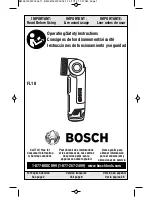
Latest products and information available at www.sealite.com
12
SL-PEL Series
Sectored Port Entry Light
NIGHT-TIME USE:
Usually one of the main reasons a port considers upgrading its leading line is due to a growth of port
infrastructure around the bearing, making it impossible for the mariner to pick out the leads. Again, a
photographic record of an approach noting possible interfering lights at night time will help to enhance
the new system. A simple addition of flood lights or an adjustment of current flood light direction could
improve recognition significantly. This exercise is also useful when determining the level of automatic
night dimming which will be discussed later in the manual.
DAY-TIME USE:
Providing a light for day use is expensive in terms of the power required to generate bright lights which is
visible in daytime. Reference to the approach bearing will determine if this is to be directly in a rising or
setting sun. Any viewing in this direction without the assistance of a dark skyline will reduce the range of
the light. The higher the mountain range or building behind the light which will create a large silhouette
will increase the range the light can achieve. Summer and winter variations of the sun’s position relative
to the bearing angle should also be considered.
It is recommended that during the project’s engineering stage that a series of pictures are taken of the
ship’s view during approach during the time of a rising or setting sun, or any other harsh conditions to
make a valid assessment of light intensity required. Sealite engineers may also be consulted for their
recommendations.
DAY AND NIGHT USE:
If the light is to be used in both day and night time applications it will most certainly require to be dimmed
for night use. This is an automatic feature built into the PEL where the user can configure the intensities
to be set. Sealite engineers have created a programme supplied with the PEL which enables the
commissioning engineer to adjust this intensity via the USB port provided.
CONSIDERING SITE SELECTION:
If the project is brand new with a new bearing line and the Harbour Master or Pilots have a choice to
select the approach line over and above any geographical restrictions on the position of rocks or reefs, it
is a useful exercise to draw the “ideal approach line.” This could be angled to suit a particular approach
if vessels will always approach from a given direction. If from either Port or Starboard of the line then the
line will need to be centralised. However, if the approach for a given size of vessel is always from the
Port side of the bearing line then the line should be angled to diminish his course change. Amounts of
dredging (if required) is always an item to be taken into consideration in terms of cost.
Once selected, the extremity of the channel or to the edge of any rocks or reefs should be drawn on
either side of this bearing line. These lines should be extended back to shore or the location from which
the PEL will be driven. Once the points have been selected, the land or sea within these two vectors can
be reviewed for suitability. Points to be considered include:
1. Ownership of the land.
2. Background on the leading line.













































